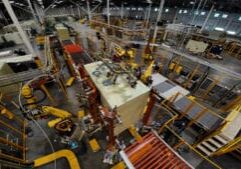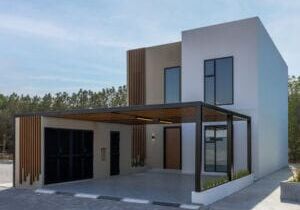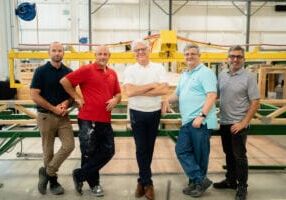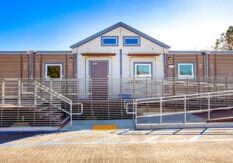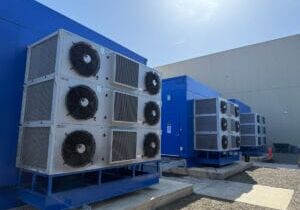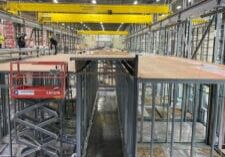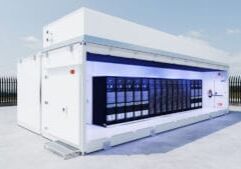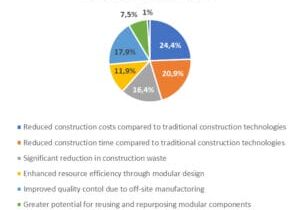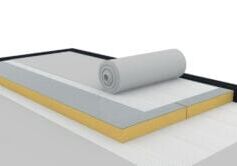How Modular Construction Will Get You a Better Return on Investment
Modular buildings are created in a factory and then shipped piece by piece to their final resting spot, at which point a team of builders and architects finishes assembling them efficiently. Though there are a number of benefits to constructing buildings offsite rather than onsite, one of the greatest benefits is the phenomenal return on investment associated with modular construction. In this guide, we'll show you the many cost savings associated with modular construction and showcase why you'll get a better return on investment with a modular building.

Faster Construction Times
If you've ever tried to build a custom building in the dead of winter or during hurricane season, you understand that the weather has a huge effect on how long it takes your building to be constructed. Inclement weather can cause traditionally constructed buildings to take months longer than anticipated.
Time is money, especially where construction is concerned. If you're creating a business, delays in construction equal delays in revenue. Hotel rooms can't be rented, hospital equipment can't be installed, and inventory can't be stocked until your building is completely constructed.
Modular buildings are significantly faster to build than traditionally crafted buildings. In fact, studies show that modular buildings take 25-50% less time to build than traditional buildings. Regardless of your situation, that saved time equals money in your pocket.
Cost Certainty
Unlike with on-site construction, off-site construction designers and architects are required to finalize their plans before they start working on your building. Changing plans is difficult once construction begins because there are so many moving parts involved. Additionally, once you've signed off on a project, the rates are set. This means no weather-related price hikes and no paying for laborers to undo or redo work. You know from the moment you sign your contract exactly what the cost will be for your business.
Fewer On-the-Job Injuries
There are a number of factors that can lead to on-the-job injuries with traditional construction. Working to a deadline despite poor weather conditions, for example, can cause workers to slip and injure themselves. On-the-job injuries can be cause for lawsuits or sudden unexpected expenses on your bill as a result of the construction company trying to recuperate their costs. Modular buildings are built in factories with stringent safety requirements during predictable business hours. This reduces the chances of on-the-job injuries and any related costs.
Reduced Waste
Traditionally constructed buildings suffer from construction waste as a result of human error. Builders might cut planks to the wrong length, for example, and have to cut them again, or it might rain when they weren't expecting it to, ruining building materials. When a building is built in a factory, a lot of this waste is eliminated. Environmental factors are a non-issue with offsite construction, and the industrialization process leads to fewer errors.
Additionally, factories are able to order materials in bulk for many orders at a time rather than just purchasing materials for your building. This means that the cost per unit of the material may be lower and they don't waste as much material on individual projects.
Conclusion
When you're creating your business, you want predictable costs so that you can plan your budget appropriately. Modular buildings build that predictability in at the beginning of the project rather than making you estimate total costs. Additionally, prefab structures allow you to have your building constructed sooner than on-site construction projects. This can provide a significant return on investment because you can open your business's doors sooner and begin making profits earlier.
More from Modular Advantage
Resia: Breaking All the Rules
Resia Manufacturing, a division of U.S.-based Resia, is now offering prefabricated bathroom and kitchen components to industry partners. Its hybrid fabrication facility produces more precise bathroom and kitchen components (modules) faster and at lower cost than traditional construction. Here’s how Resia Manufacturing does it.
How LINQ Modular Innovates to Bring Modular To The Market in the UAE and Beyond
LINQ Modular, with an office and three manufacturing facilities in Dubai, is a modular firm based in United Arab Emirates. The company is on a mission: to break open the housing and construction markets in the Gulf Cooperation Council (GCC) area with modular.
ModMax: Redefining Modular Construction with Confidence and Precision
ModMax was born out of frustration—frustration with five persistent pain points in modular construction: Permitting bottlenecks. Production delays. Rigid designs. Disconnect between “the office” and the field. Lack of transparency and communication.
LifeArk: Disaster-Resilient Housing from Recycled Plastic and 100-year-old Technology
Wee compares LifeArk’s housing units to Yeti coolers, as they are built similarly. Each component takes 15 to 20 minutes to manufacture, has an R-value of 40, and includes molded slots and chases for wiring, plumbing, fire sprinklers, and other utilities.
Building the Future of Modular Edge Infrastructure
The edge data center market is expanding rapidly, driven by the surge in AI workloads, IoT adoption, and the need for localized compute power. In these environments, sustainability, scalability, and reliability are non-negotiable. Cooling is among the most complex challenges for operators—and one of the most decisive factors in long-term success.
Accelerating Light-Gauge Steel Construction: A Semi-Automated Digital Workflow for Off-Site Projects
For construction professionals, the message is clear. By adopting semi-automation and digitalization, companies can deliver projects faster, more accurately, and more profitably, while also building stronger collaboration across teams. The approach is not about replacing people with machines, but about empowering people with better tools and processes.
Why Modular Data Centers Are Gaining Momentum
Artificial intelligence, high-performance computing, and edge applications push the limits of traditional “stick-built” data centers. They take years build, often struggle with high density workloads, and aren’t optimized for deployments near end users. Modular data center platforms are purpose-built to address these challenges, offering flexibility and scalability to adapt to evolving technologies, while opening new opportunities for the modular construction industry.
Supply Chain Innovation in Action: 5 Habits Every Modular Leader Should Practice
By applying these principles to supply chain practices — collaborative planning, strategic procurement, scenario modeling, digital tools, and transparent forecasting — construction leaders can build value chains that are not just efficient and agile, but truly innovative.
Exploring the Role of Modular Integrated Construction (MiC) in Advancing Circular City Principles – A Survey of Stakeholder Perspectives
The survey findings highlight the significant potential of Modular integrated Construction (MiC) in advancing the development of circular cities. By reducing costs, accelerating construction timelines, and minimizing waste generation, MiC offers a promising approach to sustainable urban development.
The Use of MS POLYMER™-Based Sealants and Adhesives in Modular Building
These products combine flexibility and elastic recovery with excellent adhesion to different substrates and have already shown their usefulness in traditional construction. Now it’s time for them to be put to use in the modular construction industry.

